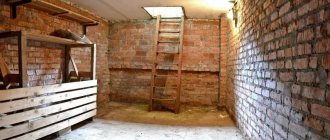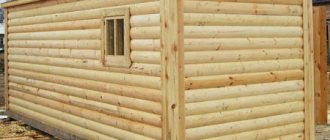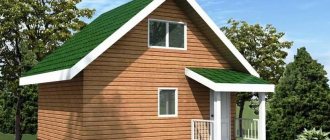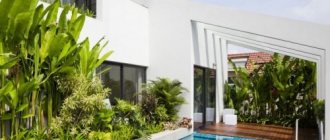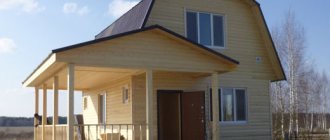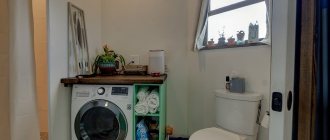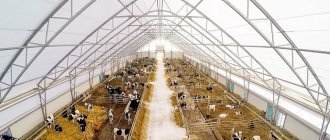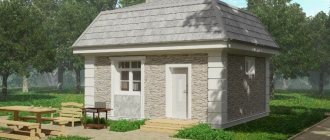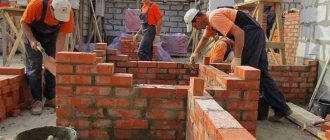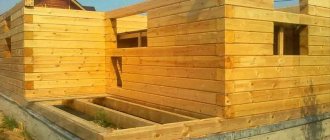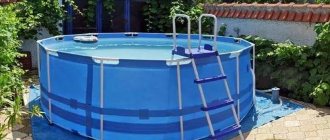For many years now, a swimming pool in a suburban area or in a country house has been perceived not as a curiosity, but as part of a comfortable life. At the same time, it is a complex and expensive structure, especially if it is a concrete pool. For those who have decided to turn their dream into reality and build a pool on their own, with minimal investment, it will be useful to get acquainted with the construction plan. I propose to understand each stage, from project development to finishing work and landscaping.
Location of technical room Source romstal.ua
Layout, choice of design and location
When deciding to build a concrete pool, owners must decide two important issues:
- Fundamental possibility of construction. In an area with high groundwater, it is recommended to abandon a concrete pool in favor of another design.
- Selecting the bowl volume. If the volume exceeds five cubic meters, then such a structure must be registered with the BTI, and construction must begin only after obtaining permits.
The location for the concrete bowl is selected taking into account the characteristics of the site and the following recommendations:
- The structure is laid at a distance from a residential building and buildings with a foundation in order to exclude a negative impact on their integrity.
- Trees should not be planted near the bowl: their root system can grow and destroy the concrete. In addition, trees are an excellent source of small debris.
- If you have a choice, it is better to place the bowl in a place with clay soil. It will serve as a natural barrier to groundwater.
- Whenever possible, consider wind protection.
- The construction site must be convenient for access by construction equipment.
Project with concrete stairs Source maja-dacha.ru
Construction features, pitfalls
The work ahead is well known to those who have built any brick building with their own hands. There are several stages to be overcome. This:
- digging a pit;
- concreting the site;
- construction of pool walls;
- its internal and external waterproofing;
- tank lining, installation of all equipment.
Construction will take time
Almost every important stage requires a technological pause. The first break is needed after pouring the concrete base, which will gain strength for 4 weeks
Finished brick walls must also be left to stand for the mortar to harden and the masonry to shrink.
Features of work
If we talk about whether the owners will cope with all the difficulties that they encounter on the way to their goal, then everything depends on their desire to make a brick pool “for centuries.” There are several particularly important points to consider.
- Absolute tightness of walls, bottom, joints of the structure. This is the main requirement. Liquid from the reservoir should not leak out. It is necessary to protect the bowl from groundwater containing “God knows what.” Sealing is needed both inside and outside.
- Water pressure on walls. Since the average artificial reservoir is forced to hold back a colossal mass of water (12-18 tons, 1 m3 weighs 1 ton), the walls must be super strong.
- The power of frost heaving. Since the walls are made up of small elements, they are easily damaged. Therefore, arranging a reliable foundation should be task No. 1.
Organizing water drainage is another requirement. A pit is dug next to the tank, its depth is greater than that of the pool. A drain pipe is inserted into it and a filter is installed. Overflow holes are made in the walls of the bowl, which will ensure a constant water level and help remove debris that regularly accumulates on the surface of the reservoir.
Ground dependence
Most often, brick pools are built, which are buried in the ground. And in this case, the soil characteristics can play a major role. Therefore, before planning the operation, it is necessary to determine the type of soil, groundwater level and freezing point.
The worst option is the groundwater level entering the freezing zone. In this case, there is a high probability that deep cracks will appear in the masonry due to frost heaving. Reinforcement will not help here. Sandy soils saturated with water are even more susceptible to frost heaving. Clay soil is quite strong, but if water is close, it will become limp.
About the technical project
Once the location has been chosen, the development of the technical design can begin. Construction work will be carried out according to this document, so all the nuances are spelled out in it:
- Construction technology, calculation of strength and durability.
- Pool parameters, including bowl shape, size and depth. Drawings are developed and dimensions are set.
- The configuration of utilities is selected. You need to think about how to fill the bowl and drain the water, and where to place the cleaning filters. You may need a heating or lighting system.
Preparatory stage
Create your own estimate for the construction of a country pool. Before calculations you need to determine:
- Pool size. Based on the budget and the number of people who will swim in it.
- Depth and its shape. If you have no experience in construction, it is better to choose a regular rectangular shape. Convenient bowl depth – from 1.5 meters.
- The thickness of the structure. The deeper the pool, the more reliable its base should be; the thickness should not be less than 15 cm.
- Geology of the site. It is better to order a geodetic study of the land plot, which will determine the density of the soil and groundwater level, and will help you choose the best place for installation.
- Pool equipment. Proper selection of equipment and embedded elements will allow you to use the pool comfortably and reliably.
- The proximity of the pool to other buildings. Neighboring foundations will put a load on the foundation pit, so all buildings must be completely autonomous.
- Materials. Construction must be carried out with high-quality and proven materials.
Need to buy swimming pool equipment
Concrete and other materials
Concrete pools have an impressive lifespan of about 60-80 years. But to make the bowl durable, you need high-quality construction materials to build a pool. The main building material, concrete, is chosen taking into account the characteristics of outdoor use. You will need concrete that is not only highly waterproof, but also resistant to temperature fluctuations, in particular frost.
Sectional view of the pool bowl Source shortpixel.ai
Experts agree that concrete should be used for structures with significant mechanical and atmospheric loads. The M350-M400 brands meet these criteria. Pay attention to additional indicators: water resistance (W6 brand is suitable) and frost resistance (F200).
I advise you not to skimp on concrete; the consequences of saving can be disastrous. If you are going to model the bowl yourself, give preference to heavy concrete from trusted manufacturers. Such brands contain hydrophobic (organic or mineral) additives and plasticizers.
To improve the quality of the bowl, equipment for vacuum and vibration processing of concrete (vacuum pump, construction vibrator) is used. Treatment helps to make the concrete pool bowl more dense, reduce the size of capillaries, and also eliminate the appearance of defects (sinks).
High-quality concrete will be the key to long-term operation Source folksland.net
If you plan to prepare the concrete mixture yourself, use the following proportion (per 1 cubic meter):
- Cement M400: 600 kg.
- Medium granulation sand: 1500-1600 kg.
- Fiber fiber (to increase strength): 800 kg.
- Plasticizer: 1 kg.
- Water. It is added according to the ratio: for one part of the material - 0.3 parts of water (the part is the weight of the components, not the volume).
You will also need reinforcement to strengthen the walls and installation equipment. Some hardware stores offer pool equipment kits, but you can assemble everything you need separately. You will need nozzles and flanges, a ladder, a pump with a filter, a skimmer, as well as finishing materials (mosaic, tile, PVC film).
Using technology will save a lot of time and effort Source stroypomochnik.ru
See also: Catalog of companies that specialize in designing and performing landscape work of any complexity
Preliminary calculations
Pit preparation
The main parameters of the future pool are width and depth. They are determined taking into account the purposes of construction. If you plan to mostly swim, choose a rectangular, slightly elongated bowl. Round bases are a convenient option for splashing around and relaxing.
The optimal depth of the pool is 1.4 m, but be sure to take into account the height of family members and the presence of children. For kids, 1 m will be plenty, but those who like to jump from a tower need at least 2 m.
The depth can be set to one or variable. Gradual deepening is optimal for families with children (there will be zones for everyone), ski jumping. The most difficult from a constructive point of view will be a combined pool for children and adults. In it, the zones are separated by a partition extending from the very bottom.
Preparation: site and pit
The first step is to plan the site: determine the exact location of the bowl, mark the outline with pegs and rope. It is important to take into account the size of the construction site itself: they should be so large that it is convenient to use machinery and small-scale mechanization.
When the markings are ready, the construction of a concrete pool begins with digging a pit. For digging, it is worth using an excavator, since manual work is labor-intensive and will take a lot of time. The walls of the pit are made with a slope to avoid scree. The bottom is constructed with a slight slope (5-7%), at the lowest point a recess is dug for a drainage well. Then prepare the sand and gravel bed in the following order:
- Crushed stone is poured into the drainage well and compacted.
- The bottom is covered in layers of sand (20-30 cm) and gravel (10 cm); Each layer is carefully compacted. At the same time, a hydraulic system for filling and draining water is laid, not forgetting the need to slope the drain pipes (4-8%).
- The bottom is waterproofed using roofing material, PVC film or bitumen mastic.
The bottom must be made with a slope Source natucer-fd28.kxcdn.com
Video description
The video shows the sequence of construction operations to install a plastic pool:
Composite pools
The raw material is fiberglass. This is a polymer based on polyester resins with the addition of glass fiber, which acts as a reinforcing frame. This composite produces lightweight but very durable structures. By the way, the hulls of boats, yachts and boats are made from it today.
Fiberglass products have a more durable structure than plastic ones. They will last at least 50 years. As for the installation method, it is exactly the same as for polystyrene models. But there is another simplified option.
- a cushion
at the bottom of the dug pit . - A bowl
is installed on it , which is set horizontally. - Fill
the space between the pool and the walls of the pit with a mixture of sand and crushed stone in a 1:1 ratio, which is compacted well. There is no need to pour water into the reservoir when adding.
Which pool is better to buy for your dacha: plastic or fiberglass. It’s probably incorrect to pose the question this way. It all depends on the price of the product and the purchasing power of consumers. Plastic ones are cheaper than composite ones, but the latter have a longer service life.
Construction of the bottom of the bowl
The bowl is the central and most labor-intensive part of the pool. Its construction begins by filling the bottom with concrete mortar. If you can fit special equipment to the pit, it makes sense to purchase ready-made concrete mortar. But you can also prepare it yourself using cement (325 kg), sand (625 kg), water (170 l) and crushed stone (1250 kg).
The bottom also needs to be reinforced with reinforcing mesh. For its manufacture, rods with a diameter of 12-18 mm are used; The cell size is 15-25 cm. It is not necessary to weld the rods; it is enough to secure them together with thin wire. Filling is performed in two ways:
- Pour a layer of concrete 5 cm thick. Wait for the concrete screed to dry, lay out the reinforcing mesh and fill it with the second layer of screed.
- For those who want to make a concrete pool faster, the second method is suitable. Pouring is done in one step: first, a reinforcing mesh is assembled, which is placed on bricks (or other supports) to maintain the distance to the pillow. Then pour out all the concrete solution to cover the reinforcement.
Fragment of reinforcing mesh Source ytimg.com
Creating a frame pool
How to make a pool with your own hands in the yard from a frame? The first is choosing a location and determining how much the pool will be dug into the ground or whether it will be installed on the surface of the earth. If the latter option, then step by step construction in the courtyard of a private house looks like this:
- Align the selected area;
- We fill it with sand;
- We ram;
- We fill it with gravel;
- Cover with two layers of roofing material overlapping and seal;
- We can concrete it – for greater stability and reliability;
We purchase PVC fabric, from which we need to make a pool in the yard.
In any case, you need to have the following tools available:
- Master OK;
- Meter;
- Level and plumb;
- Shovel;
- Construction tape;
- Sharp knife;
- Hacksaw;
- Container for mixing concrete;
- Construction mixer;
- Self-tapping screws;
- Metal rings;
- Washers – large and press washers.
Then we begin to build a pool with our own hands in the courtyard of a country house:
- We lay out the PVC sheet on a clean, flat surface, where we will cut the container and glue its parts together using welding.
- We weld the parts of the fabric with an overlap of 2-2.5 cm. Before welding, we press the parts with a rolling roller. The tightness of the bowl will depend entirely on the quality of the welding seams, so welding must be done very carefully.
- The upper part of the bowl must be prepared for the rings needed to tension the fabric during use. To do this, simply bend the top edge by 60 cm and weld.
- We install the frame on a prepared, level base—preferably sunk into the soil. To do this, we mark the corners, prepare 50-60 cm recesses according to the markings and install the racks - with a level we monitor the vertical position of the racks.
- After installation, the earth holes are filled with crushed stone and covered with bitumen waterproofing, especially at the ends.
- We fix the beam and fill the boards strictly horizontally using self-tapping screws; the lower strapping of the fence is done with a shalevka.
- Installation of additional racks in the presence of a ladder for descending into the water.
- Before installing the frame bowl, a sand cushion is poured onto the bottom.
- The sides are built horizontally and efficiently, because in the future they will be pressed by a huge mass of water. Self-tapping screws with a press washer and auxiliary large washers are used for fastening.
- The frame should be well tensioned and pressed against the sides with self-tapping screws.
Construction of bowl walls
When the bottom is formed, wait for the screed to dry, periodically wetting the concrete with water (then drying will be uniform). After the bottom has dried, the walls are poured; the process consists of the following steps:
- Formwork is prepared from boards 30 mm thick; 5x5 cm timber is chosen for the stiffening ribs. If formwork of an unusual (bent) shape is needed, the boards are replaced with laminated plywood. At this point, check that all the necessary mounting holes are filled.
- To reinforce the pool bowl, metal rods with a diameter of 12-20 mm are used (calculated by the project). The rods are placed immediately after pouring the first portion of concrete, until the mixture hardens.
- Concrete is poured in layers; the thickness of each layer is about 15 cm. After 4-5 days, the walls will become hard enough to remove the formwork.
Reinforcing mesh in a bowl of complex configuration Source swimsv.com
- Before pouring the first layer, the base of the walls is moistened; this improves the adhesion of dried concrete and fresh mortar. For the same purpose, aluminum powder is mixed into the first portion of the solution (for the bottom layer).
- There is a second method, when pouring concrete is done at one time. This is argued by the fact that there will be no joining seams between the layers on the walls, and the structure will be homogeneous.
- After pouring, the concrete must strengthen and stand. This may take from two weeks to a month. The concrete surface is periodically moistened with water throughout the drying period.
- If the project provides for a concrete staircase (Roman steps), a separate sheathing is installed for it after the bowl has completely hardened.
Plywood formwork Source kamtehnopark.ru
Reinforcement of the bottom plate
Before pouring the structure with concrete, we perform reinforcement work on the bottom of the pool. We use reinforcement measuring 8-12 cm. We treat it with a special anti-corrosion agent twice. We lay the rods horizontally and vertically to obtain reinforcement in the form of a 20*20 cm cage. We make two levels of reinforced mesh, and tie the intersections of the frame with special wire or plastic clips.
Reinforcement of the bottom plate
The frame rods cannot be connected with a welding machine, as they will be subject to rapid corrosion. We install the necessary embedded elements at the bottom of the pit and secure them with wire; if necessary, protect them with formwork
In order for the concrete pool bowl to be strong and reinforced, it is important to place the frame on special supports or bricks, so that the reinforcement will be inside the concrete screed. We bend the rods upward along the perimeter of the bottom (later we will secure them with the reinforcement rods of the pool walls)
Laying waterproofing
The pool construction technology includes waterproofing, which can be carried out using two methods. Some experts believe that the protective layer should cover the entire surface of the bowl, while others recommend waterproofing only the seams.
The work uses roofing felt sheets, bitumen, and liquid rubber. A PVC membrane and hydrophobic dry (or two-component) building mixtures are suitable. Liquid materials are applied in two layers, preferably with a reinforcing mesh.
When choosing a material, it is necessary to calculate the costs, since the surface of the pool has a fairly large area. The quality of waterproofing can be improved by pre-leveling the walls by sanding.
Finishing work and landscaping
The final stage, finishing the pool, is performed in the following order:
- Prepare the surface of the bowl: plaster it with a suitable composition, install embedded elements.
- The edge is decorated with decorative sides, which are laid out of brick or cast from concrete. Additional equipment is installed: hydromassage unit, stairs, slide, counterflow.
- To cover the pool bowl, choose ceramic tiles, mosaics or PVC film; the latter is the most budget option.
Decorative design of the bowl Source pinimg.com
Tiles are chosen most often, but it must be taken into account that there are certain subtleties in its installation. The fact is that under water pressure the surface of the bowl can be slightly deformed. To take into account possible changes, the seam between the tiles is made wide enough.
Also, only elastic adhesives and grouts that can withstand low temperatures are used. If the pool has a complex configuration, mosaic is chosen instead of tiles. After finishing the facing work, allow the glue to dry and fill the bowl again to evaluate the quality of the coating and the operation of the equipment.
The pool is the decoration of the site, so it needs an appropriate frame. You might want to add a roof to it; If there are children in the house, put up a fence. The relaxation area around the pool also needs improvement. To make it comfortable, flower beds are laid out, paths are laid, and space is allocated for umbrellas and sun loungers. A stylish addition would be surface and underwater lighting, a flat, cascading or jet waterfall.
Recreation area with swimming pool Source 8×4.com.ua
Cleaning system
Setting up a swimming pool is impossible without a cleaning system. If you do not use a special device, the water in the pool will become dirty and an unpleasant odor will appear. A specific coating will appear on its surface.
The most budget option is to use a pump to pump out water. You completely drain the contaminated water and fill the pool with clean water. But there is one drawback to this method: it will take time for the water to warm up again.
You can install a special installation with a filter for cleaning. Two pipes are connected to the pump. One of them drains the water, the second supplies the purified and filtered water back into the pool. Filters can be sand, cartridge, or diatomaceous earth.
Chemical reagents are also used for cleaning and disinfection. These include chlorine, bromine, perhydrol, or products specifically designed for this purpose. Before use, be sure to read the instructions.
Briefly about the main thing
A concrete pool is a rather complex structure for a private plot, so a technical design is developed for it, which is then approved and registered with the BTI. Construction includes several stages, from digging a pit to cladding and arrangement of the surrounding area.
Correct execution of each stage will ensure the durability and integrity of the structure. Particular attention is paid to laying the bottom and pouring the walls of the bowl; it is important to use high-quality, frost-resistant and impenetrable concrete. High-quality waterproofing and finishing will make the operation of the structure trouble-free.
